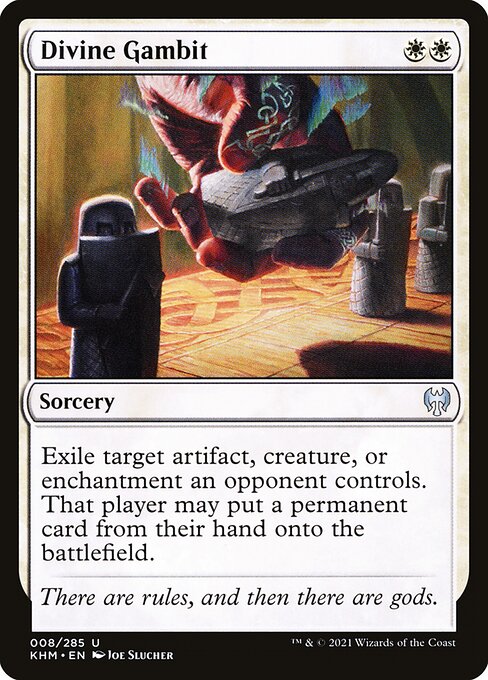
Image courtesy of Scryfall.com
Pivoting Strategies After Divine Gambit Is Countered
Divine Gambit is the kind of spell that sounds cinematic: two white mana, a dramatic promise, and a choice that can tilt the board. Yet in the heat of battle, your opponent may counter it, leaving you with a mana curve and a plan that didn’t quite land. That moment is gold for pivoting. In a white-dominated frame, the real skill isn’t just what Divine Gambit does when it resolves, but how you pivot when it doesn’t. Let’s unpack how to turn a countered gambit into a pathway to enduring advantage, with the flavor of Kaldheim’s gods whispering in your ear 🧙♂️🔥💎⚔️.
Divine Gambit comes from the Kaldheim set, a little gem of a card that embodies white's protective instincts and its knack for turning punishment into parity. Its oracle text — Exile target artifact, creature, or enchantment an opponent controls. That player may put a permanent card from their hand onto the battlefield — is a tempting “give-and-take” moment. If your opponent Answers with a counterspell, you don’t just lose one spell; you lose a tempo swing. The pivot is to recognize that white’s strength after a miss is in tempo-preserving plays, resilient value engines, and a plan that survives counterattacks. 🧭
Three practical pivots for a countered Divine Gambit
- Shift to repetition and value engines — White can lean on repeatable effects and flicker-friendly plays to rebuild momentum. If your gambit fizzles on the stack, consider spells or effects that let you recast and reprice the board on the next turn. Cards that blink your own value creatures or ETB triggers can recoup tempo, letting you reestablish advantage even after a counter. Think in terms of engines that reward you for sticking through the blow — a good pivot is a plan that keeps applying pressure while you wait for the right moment to reattempt the gambit or pursue a different route to victory. 🧙♂️🎨
- Build a durable withdrawal plan with removal and protection — White’s suite of efficient removal, protective auras, and defensive bodies gives you a sturdy fallback. After a counter, you can pivot into a tempo-leaning lane: remove the biggest threat on sight, then drop a resilient blocker or a threat that nudges the board into your favor. The key is not to chase the same gambit but to convert the mana spent into incremental board presence and inevitability through steady removal-backed pressure. A few well-timed removals paired with white’s sturdy creatures can grind you back into a winning position before your next big play. 🗡️
- Leverage ETB and blink synergy to reframe the board — White loves value from enter-the-battlefield effects and blink effects. If you anticipate counterspells, you can deploy threats that offer repeat value when they come back from exile or when they re-enter the battlefield, effectively turning a failed gambit into a longer game plan. Cards like blink enablers or instant-speed returns to hand can create a fallback path to victory, even if your initial gambit never resolves. This is where the flavor of white’s guardianship shines: you’re protecting your plan while still delivering pressure. 🧿
When Divine Gambit is countered, you’re not out of gas — you’re reframing the battlefield. In white, there’s elegance in turning an opponent’s counterspell into your own tempo by selecting lines that reward persistence, not one-shot miracles. The card’s flavor text, “There are rules, and then there are gods,” aptly captures the mindset: you’re not just playing a spell; you’re playing for inevitability, and pivoting effectively is how you ride that divine wave after the misstep. 🔥⚖️
One practical mindset shift: treat the moment the gambit is countered as a new game state where you value tempo and resilience over a single clever exchange. The more your deck includes options to recast, blink, protect, or reapply pressure, the less a counterspell stings. This is the essence of strategic white: survive the counter, gain incremental advantage, and find the next precise moment to tilt the board back in your favor. 🎲
Flavor, design, and the value of Divine Gambit in the wider metagame
Divine Gambit sits at a crossroads of exile and “you may cast.” In practice, that dual nature is a design exercise in risk, reward, and timing. The exile clause invites you to think about how your opponent interacts with their own threats, while the optional battlefield entry for a permanent from hand invites a strategic gambit of misdirection and timing. When countered, the card’s value proposition remains immense: it teaches you to pivot into a white-centric plan that emphasizes board presence, tempo, and the exploitation of your opponent’s expectations. It’s a card that rewards thoughtful sequencing and a calm, gamified mind with a taste for the dramatic. 🎨
As you refine your own pivot strategies, consider pairing Divine Gambit with protection layers and blink-friendly partners to keep options open. The Kaldheim era was all about mythic storytelling meeting practical gameplay, and this card embodies that tension: it asks you to take a leap, and when that leap is blocked, you land somewhere with a new set of possibilities. The result is a memorable arc of strategy that fits beautifully into white-based control and midrange shells, delivering a satisfying blend of nostalgia and modern puzzle-solving for MTG fans. 🧙♂️
To explore more angles on strategic thinking in MTG and how creator communities discuss game theory around cards like Divine Gambit, our network has a few gems you might enjoy. And speaking of gems, if you’re ever in the market for a real-world desk companion that matches the vibe of a strategic MTG session, check out the product link below. 🧠💎
Phone Stand for Smartphones — Two Piece Hardboard Desk DecorMore from our network
- https://blog.digital-vault.xyz/blog/post/sea-dasher-octopus-rethinking-creature-combat-math-in-mtg/
- https://crypto-acolytes.xyz/blog/post/best-retro-wrestling-titles-belts-that-shaped-an-era/
- https://transparent-paper.shop/blog/post/practical-hashtag-tips-to-boost-reach/
- https://blog.digital-vault.xyz/blog/post/parallax-shrinks-with-distance-in-a-distant-blue-star/
- https://crypto-acolytes.xyz/blog/post/minecraft-dolphin-tricks-quick-tips-for-ocean-travel/